BAO5524 Professional Auditing Assignment: BSL Audit Report 2018
VerifiedAdded on 2023/01/16
|21
|4626
|96
Report
AI Summary
This report provides a comprehensive analysis of the audit of Biofuel Solutions Ltd (BSL) for the year ended December 31, 2018. It begins with an introduction to auditing and assurance services, emphasizing their importance in business operations. The report includes a SWOT analysis to evaluate business risks, identifying operational, innovation, legal, and credit risks. It then details major risk areas, such as liquidity, debtor turnover, salaries, and share cancellations, supported by ratio analysis and financial data. Risk management strategies are proposed to address operational, credit, technological, and legal risks. The report also examines the strengths and weaknesses of BSL's purchase system, along with audit tests. Furthermore, it presents actions to address concerns raised, outlines audit procedures for important processing, and analyzes the audit of non-current assets. The report concludes with a summary of findings and recommendations, supported by references.
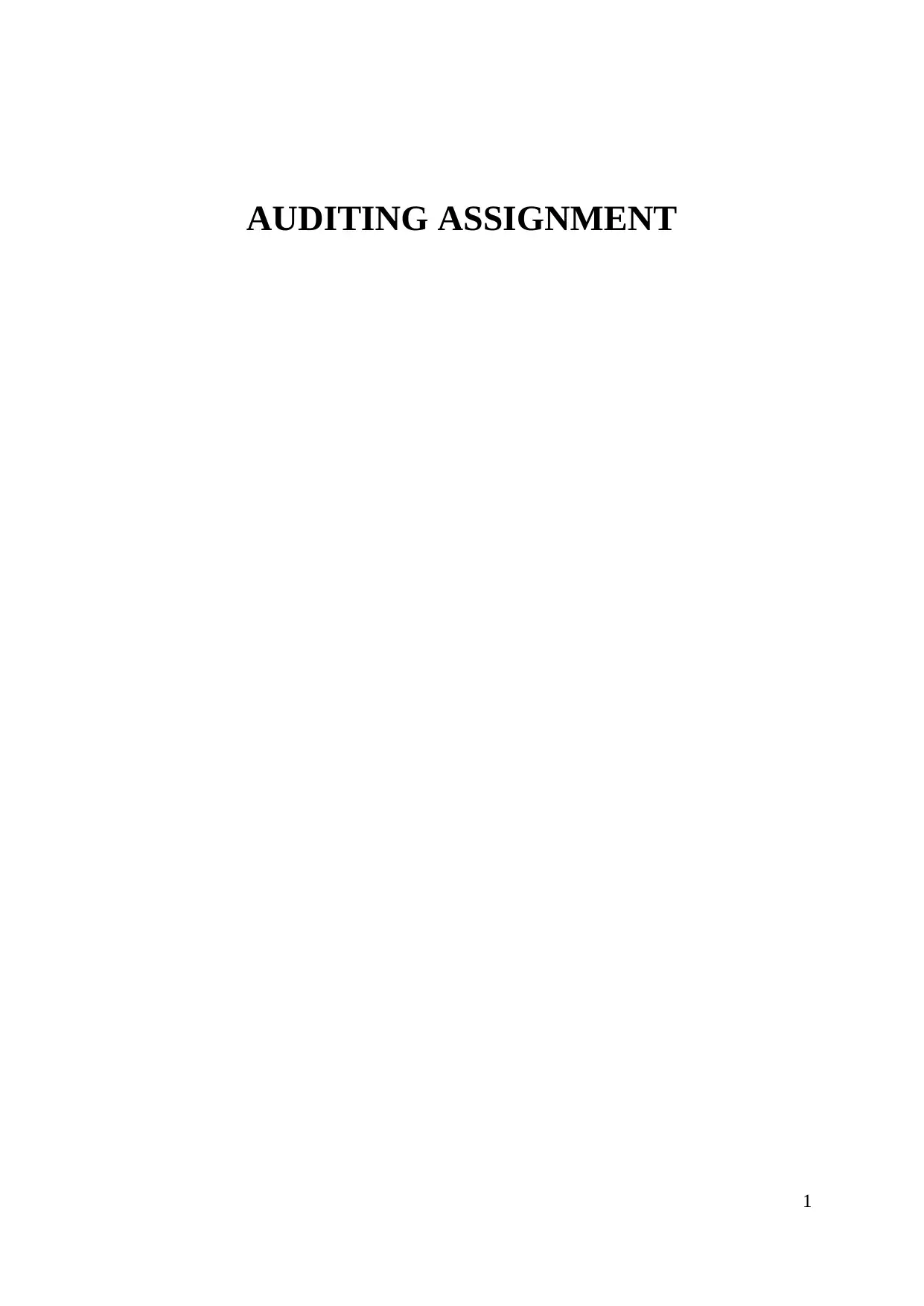
AUDITING ASSIGNMENT
1
1
Paraphrase This Document
Need a fresh take? Get an instant paraphrase of this document with our AI Paraphraser
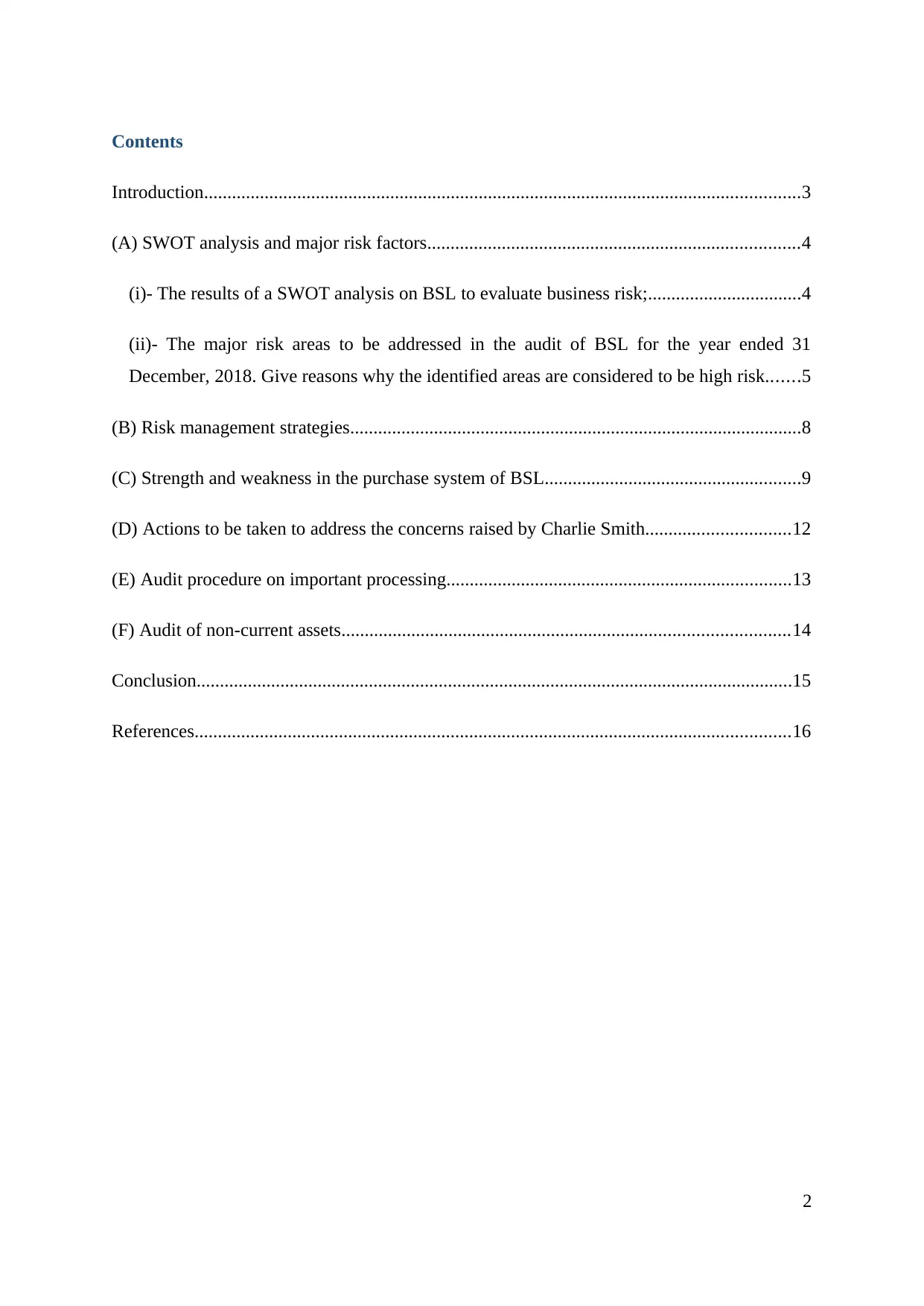
Contents
Introduction................................................................................................................................3
(A) SWOT analysis and major risk factors................................................................................4
(i)- The results of a SWOT analysis on BSL to evaluate business risk;.................................4
(ii)- The major risk areas to be addressed in the audit of BSL for the year ended 31
December, 2018. Give reasons why the identified areas are considered to be high risk.......5
(B) Risk management strategies.................................................................................................8
(C) Strength and weakness in the purchase system of BSL.......................................................9
(D) Actions to be taken to address the concerns raised by Charlie Smith...............................12
(E) Audit procedure on important processing..........................................................................13
(F) Audit of non-current assets................................................................................................14
Conclusion................................................................................................................................15
References................................................................................................................................16
2
Introduction................................................................................................................................3
(A) SWOT analysis and major risk factors................................................................................4
(i)- The results of a SWOT analysis on BSL to evaluate business risk;.................................4
(ii)- The major risk areas to be addressed in the audit of BSL for the year ended 31
December, 2018. Give reasons why the identified areas are considered to be high risk.......5
(B) Risk management strategies.................................................................................................8
(C) Strength and weakness in the purchase system of BSL.......................................................9
(D) Actions to be taken to address the concerns raised by Charlie Smith...............................12
(E) Audit procedure on important processing..........................................................................13
(F) Audit of non-current assets................................................................................................14
Conclusion................................................................................................................................15
References................................................................................................................................16
2
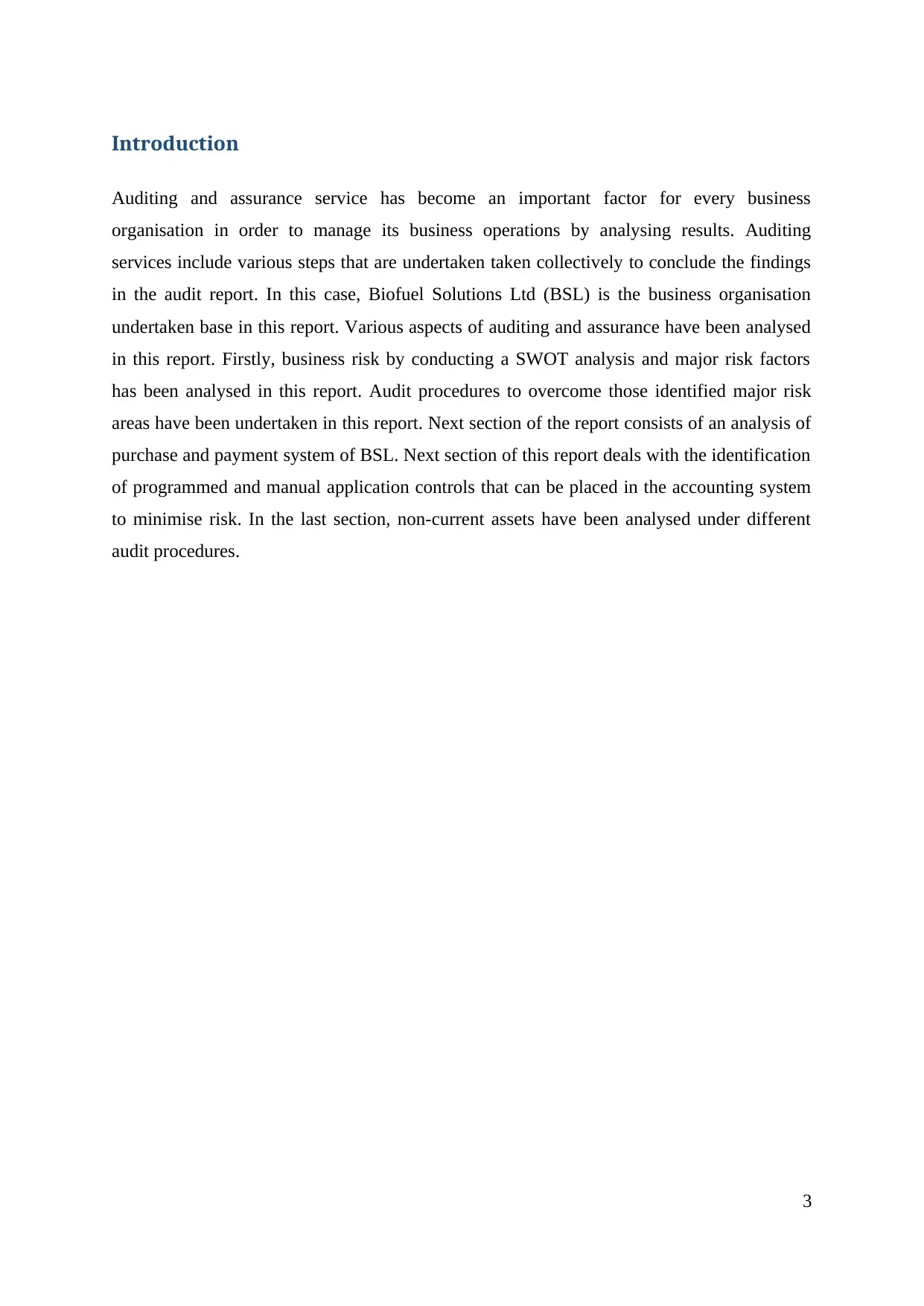
Introduction
Auditing and assurance service has become an important factor for every business
organisation in order to manage its business operations by analysing results. Auditing
services include various steps that are undertaken taken collectively to conclude the findings
in the audit report. In this case, Biofuel Solutions Ltd (BSL) is the business organisation
undertaken base in this report. Various aspects of auditing and assurance have been analysed
in this report. Firstly, business risk by conducting a SWOT analysis and major risk factors
has been analysed in this report. Audit procedures to overcome those identified major risk
areas have been undertaken in this report. Next section of the report consists of an analysis of
purchase and payment system of BSL. Next section of this report deals with the identification
of programmed and manual application controls that can be placed in the accounting system
to minimise risk. In the last section, non-current assets have been analysed under different
audit procedures.
3
Auditing and assurance service has become an important factor for every business
organisation in order to manage its business operations by analysing results. Auditing
services include various steps that are undertaken taken collectively to conclude the findings
in the audit report. In this case, Biofuel Solutions Ltd (BSL) is the business organisation
undertaken base in this report. Various aspects of auditing and assurance have been analysed
in this report. Firstly, business risk by conducting a SWOT analysis and major risk factors
has been analysed in this report. Audit procedures to overcome those identified major risk
areas have been undertaken in this report. Next section of the report consists of an analysis of
purchase and payment system of BSL. Next section of this report deals with the identification
of programmed and manual application controls that can be placed in the accounting system
to minimise risk. In the last section, non-current assets have been analysed under different
audit procedures.
3
⊘ This is a preview!⊘
Do you want full access?
Subscribe today to unlock all pages.

Trusted by 1+ million students worldwide
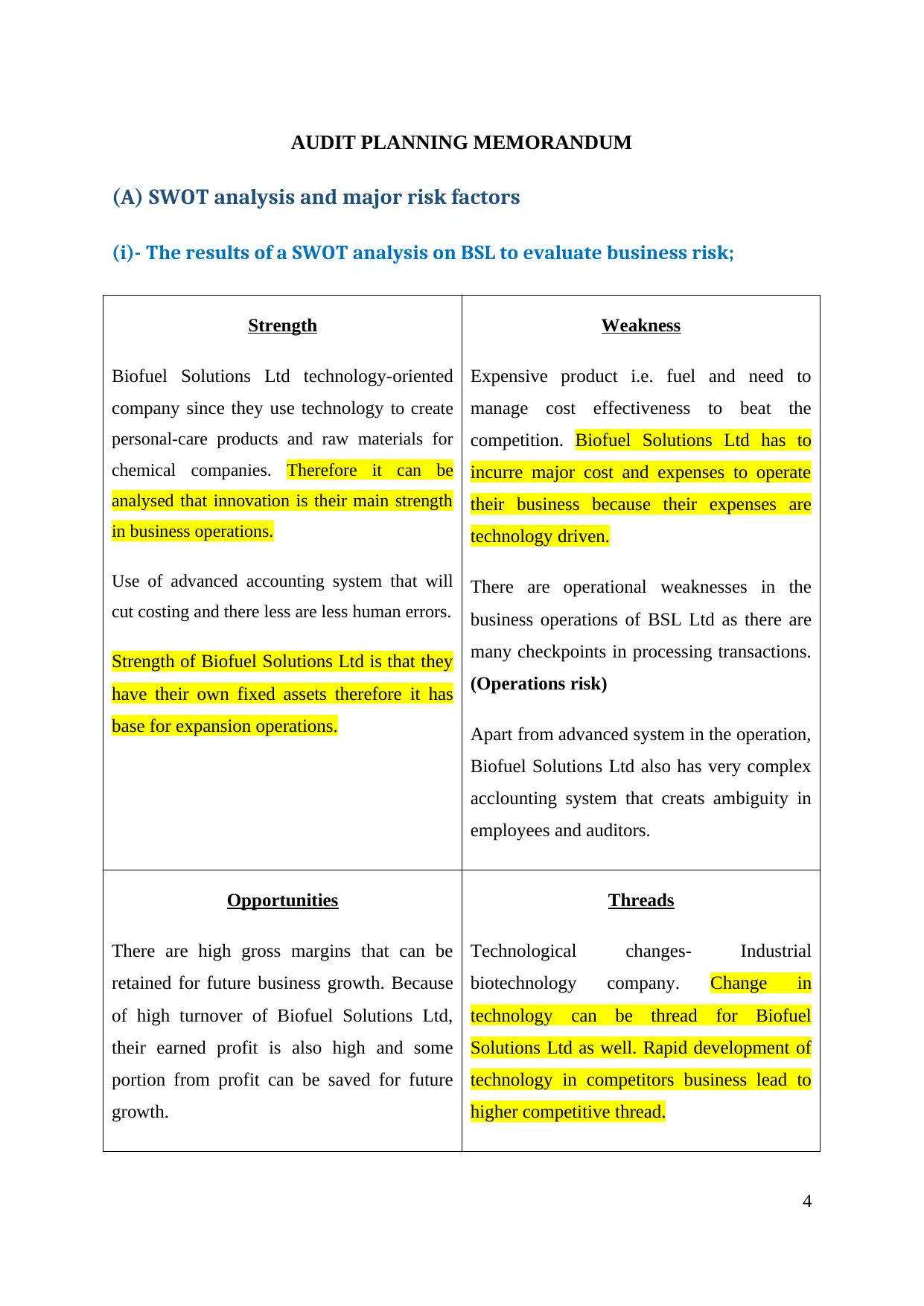
AUDIT PLANNING MEMORANDUM
(A) SWOT analysis and major risk factors
(i)- The results of a SWOT analysis on BSL to evaluate business risk;
Strength
Biofuel Solutions Ltd technology-oriented
company since they use technology to create
personal-care products and raw materials for
chemical companies. Therefore it can be
analysed that innovation is their main strength
in business operations.
Use of advanced accounting system that will
cut costing and there less are less human errors.
Strength of Biofuel Solutions Ltd is that they
have their own fixed assets therefore it has
base for expansion operations.
Weakness
Expensive product i.e. fuel and need to
manage cost effectiveness to beat the
competition. Biofuel Solutions Ltd has to
incurre major cost and expenses to operate
their business because their expenses are
technology driven.
There are operational weaknesses in the
business operations of BSL Ltd as there are
many checkpoints in processing transactions.
(Operations risk)
Apart from advanced system in the operation,
Biofuel Solutions Ltd also has very complex
acclounting system that creats ambiguity in
employees and auditors.
Opportunities
There are high gross margins that can be
retained for future business growth. Because
of high turnover of Biofuel Solutions Ltd,
their earned profit is also high and some
portion from profit can be saved for future
growth.
Threads
Technological changes- Industrial
biotechnology company. Change in
technology can be thread for Biofuel
Solutions Ltd as well. Rapid development of
technology in competitors business lead to
higher competitive thread.
4
(A) SWOT analysis and major risk factors
(i)- The results of a SWOT analysis on BSL to evaluate business risk;
Strength
Biofuel Solutions Ltd technology-oriented
company since they use technology to create
personal-care products and raw materials for
chemical companies. Therefore it can be
analysed that innovation is their main strength
in business operations.
Use of advanced accounting system that will
cut costing and there less are less human errors.
Strength of Biofuel Solutions Ltd is that they
have their own fixed assets therefore it has
base for expansion operations.
Weakness
Expensive product i.e. fuel and need to
manage cost effectiveness to beat the
competition. Biofuel Solutions Ltd has to
incurre major cost and expenses to operate
their business because their expenses are
technology driven.
There are operational weaknesses in the
business operations of BSL Ltd as there are
many checkpoints in processing transactions.
(Operations risk)
Apart from advanced system in the operation,
Biofuel Solutions Ltd also has very complex
acclounting system that creats ambiguity in
employees and auditors.
Opportunities
There are high gross margins that can be
retained for future business growth. Because
of high turnover of Biofuel Solutions Ltd,
their earned profit is also high and some
portion from profit can be saved for future
growth.
Threads
Technological changes- Industrial
biotechnology company. Change in
technology can be thread for Biofuel
Solutions Ltd as well. Rapid development of
technology in competitors business lead to
higher competitive thread.
4
Paraphrase This Document
Need a fresh take? Get an instant paraphrase of this document with our AI Paraphraser
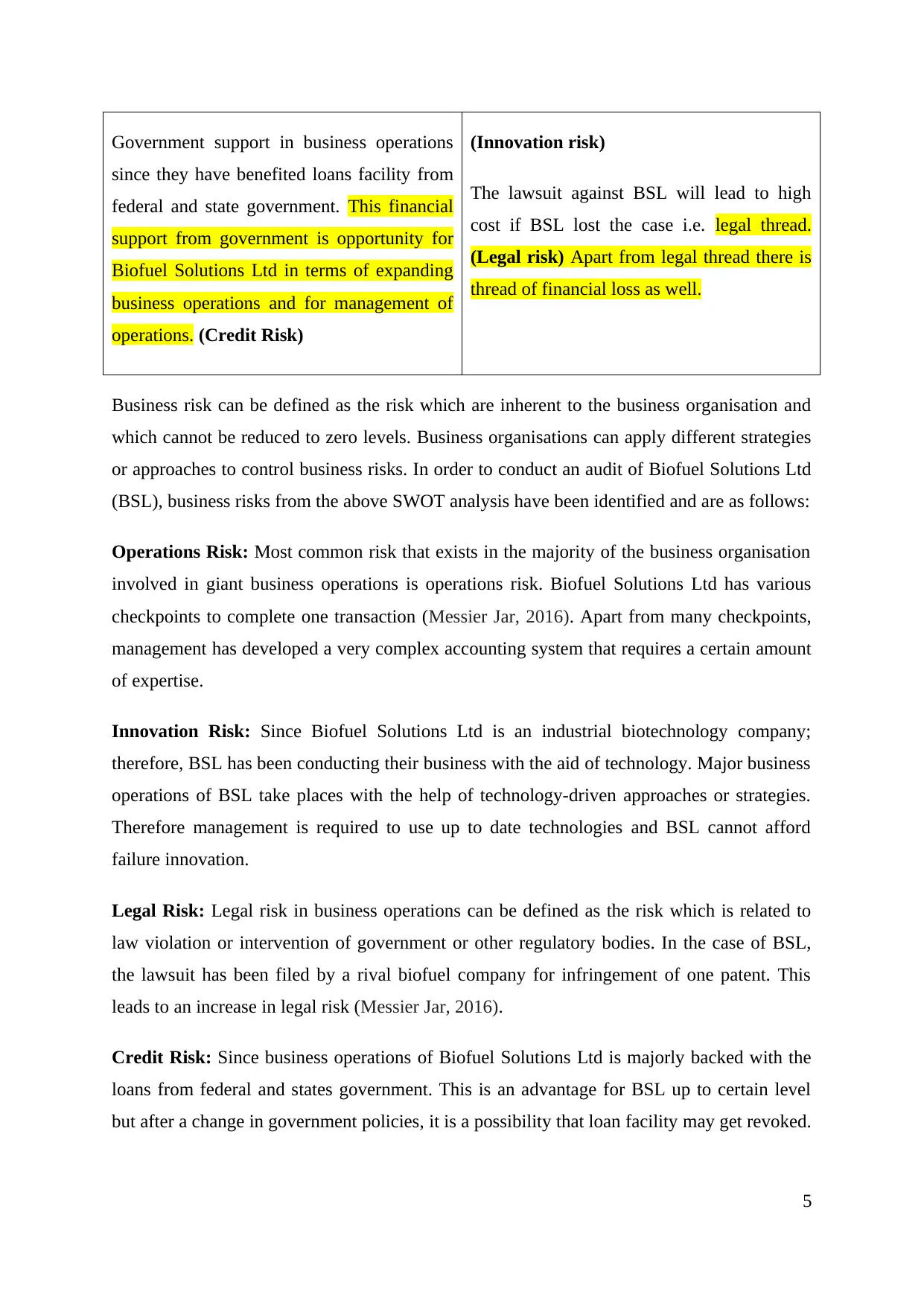
Government support in business operations
since they have benefited loans facility from
federal and state government. This financial
support from government is opportunity for
Biofuel Solutions Ltd in terms of expanding
business operations and for management of
operations. (Credit Risk)
(Innovation risk)
The lawsuit against BSL will lead to high
cost if BSL lost the case i.e. legal thread.
(Legal risk) Apart from legal thread there is
thread of financial loss as well.
Business risk can be defined as the risk which are inherent to the business organisation and
which cannot be reduced to zero levels. Business organisations can apply different strategies
or approaches to control business risks. In order to conduct an audit of Biofuel Solutions Ltd
(BSL), business risks from the above SWOT analysis have been identified and are as follows:
Operations Risk: Most common risk that exists in the majority of the business organisation
involved in giant business operations is operations risk. Biofuel Solutions Ltd has various
checkpoints to complete one transaction (Messier Jar, 2016). Apart from many checkpoints,
management has developed a very complex accounting system that requires a certain amount
of expertise.
Innovation Risk: Since Biofuel Solutions Ltd is an industrial biotechnology company;
therefore, BSL has been conducting their business with the aid of technology. Major business
operations of BSL take places with the help of technology-driven approaches or strategies.
Therefore management is required to use up to date technologies and BSL cannot afford
failure innovation.
Legal Risk: Legal risk in business operations can be defined as the risk which is related to
law violation or intervention of government or other regulatory bodies. In the case of BSL,
the lawsuit has been filed by a rival biofuel company for infringement of one patent. This
leads to an increase in legal risk (Messier Jar, 2016).
Credit Risk: Since business operations of Biofuel Solutions Ltd is majorly backed with the
loans from federal and states government. This is an advantage for BSL up to certain level
but after a change in government policies, it is a possibility that loan facility may get revoked.
5
since they have benefited loans facility from
federal and state government. This financial
support from government is opportunity for
Biofuel Solutions Ltd in terms of expanding
business operations and for management of
operations. (Credit Risk)
(Innovation risk)
The lawsuit against BSL will lead to high
cost if BSL lost the case i.e. legal thread.
(Legal risk) Apart from legal thread there is
thread of financial loss as well.
Business risk can be defined as the risk which are inherent to the business organisation and
which cannot be reduced to zero levels. Business organisations can apply different strategies
or approaches to control business risks. In order to conduct an audit of Biofuel Solutions Ltd
(BSL), business risks from the above SWOT analysis have been identified and are as follows:
Operations Risk: Most common risk that exists in the majority of the business organisation
involved in giant business operations is operations risk. Biofuel Solutions Ltd has various
checkpoints to complete one transaction (Messier Jar, 2016). Apart from many checkpoints,
management has developed a very complex accounting system that requires a certain amount
of expertise.
Innovation Risk: Since Biofuel Solutions Ltd is an industrial biotechnology company;
therefore, BSL has been conducting their business with the aid of technology. Major business
operations of BSL take places with the help of technology-driven approaches or strategies.
Therefore management is required to use up to date technologies and BSL cannot afford
failure innovation.
Legal Risk: Legal risk in business operations can be defined as the risk which is related to
law violation or intervention of government or other regulatory bodies. In the case of BSL,
the lawsuit has been filed by a rival biofuel company for infringement of one patent. This
leads to an increase in legal risk (Messier Jar, 2016).
Credit Risk: Since business operations of Biofuel Solutions Ltd is majorly backed with the
loans from federal and states government. This is an advantage for BSL up to certain level
but after a change in government policies, it is a possibility that loan facility may get revoked.
5
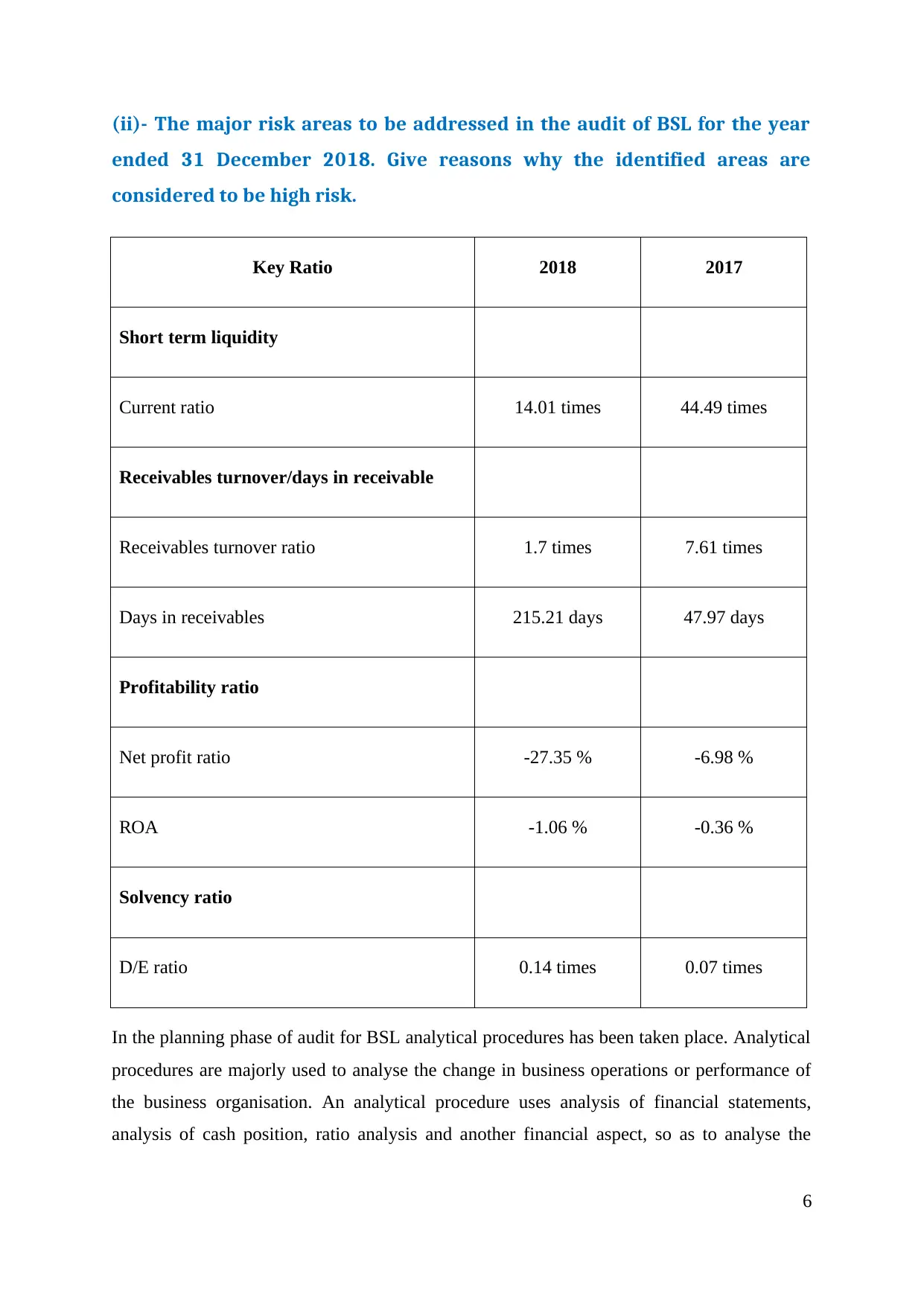
(ii)- The major risk areas to be addressed in the audit of BSL for the year
ended 31 December 2018. Give reasons why the identified areas are
considered to be high risk.
Key Ratio 2018 2017
Short term liquidity
Current ratio 14.01 times 44.49 times
Receivables turnover/days in receivable
Receivables turnover ratio 1.7 times 7.61 times
Days in receivables 215.21 days 47.97 days
Profitability ratio
Net profit ratio -27.35 % -6.98 %
ROA -1.06 % -0.36 %
Solvency ratio
D/E ratio 0.14 times 0.07 times
In the planning phase of audit for BSL analytical procedures has been taken place. Analytical
procedures are majorly used to analyse the change in business operations or performance of
the business organisation. An analytical procedure uses analysis of financial statements,
analysis of cash position, ratio analysis and another financial aspect, so as to analyse the
6
ended 31 December 2018. Give reasons why the identified areas are
considered to be high risk.
Key Ratio 2018 2017
Short term liquidity
Current ratio 14.01 times 44.49 times
Receivables turnover/days in receivable
Receivables turnover ratio 1.7 times 7.61 times
Days in receivables 215.21 days 47.97 days
Profitability ratio
Net profit ratio -27.35 % -6.98 %
ROA -1.06 % -0.36 %
Solvency ratio
D/E ratio 0.14 times 0.07 times
In the planning phase of audit for BSL analytical procedures has been taken place. Analytical
procedures are majorly used to analyse the change in business operations or performance of
the business organisation. An analytical procedure uses analysis of financial statements,
analysis of cash position, ratio analysis and another financial aspect, so as to analyse the
6
⊘ This is a preview!⊘
Do you want full access?
Subscribe today to unlock all pages.

Trusted by 1+ million students worldwide
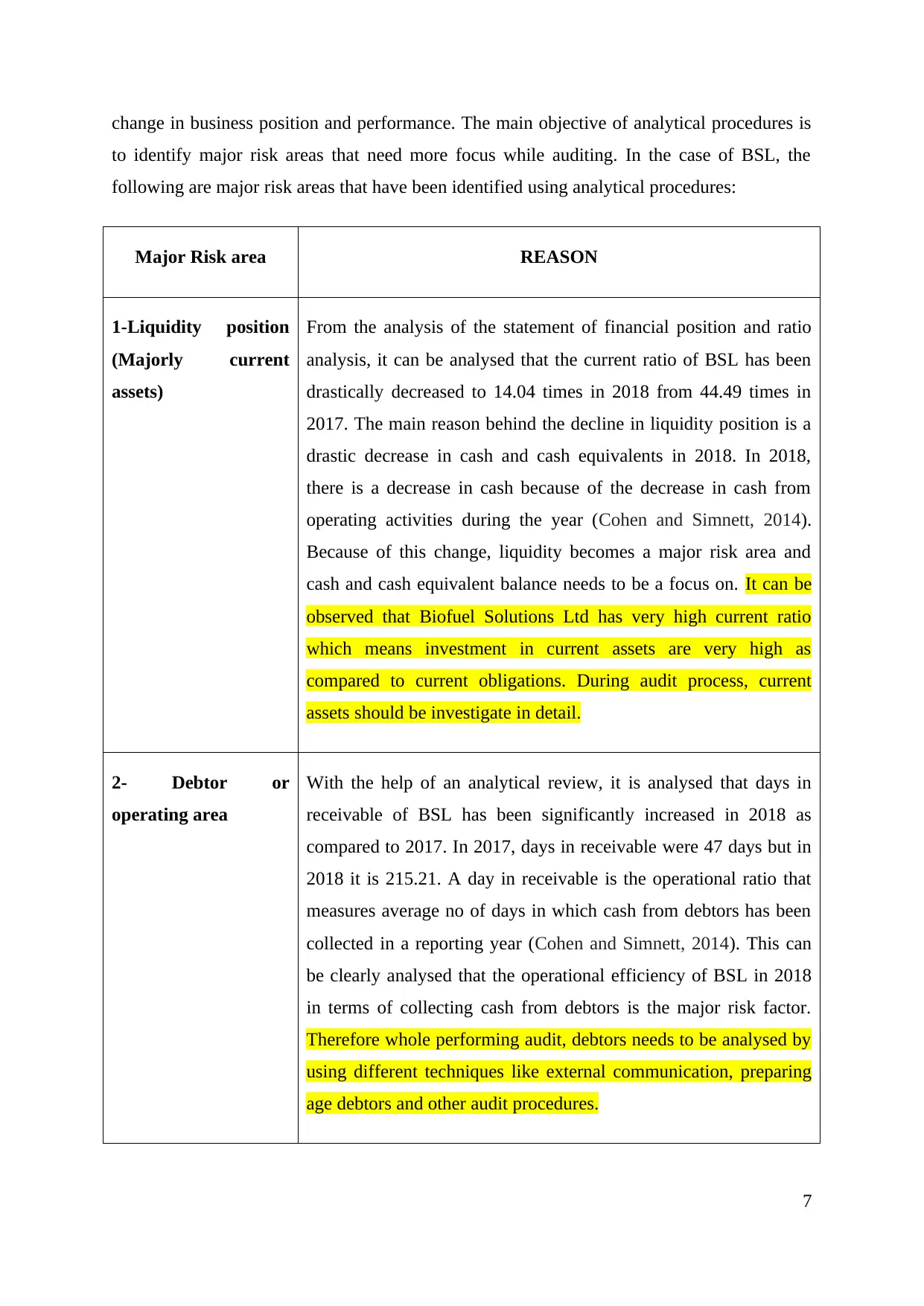
change in business position and performance. The main objective of analytical procedures is
to identify major risk areas that need more focus while auditing. In the case of BSL, the
following are major risk areas that have been identified using analytical procedures:
Major Risk area REASON
1-Liquidity position
(Majorly current
assets)
From the analysis of the statement of financial position and ratio
analysis, it can be analysed that the current ratio of BSL has been
drastically decreased to 14.04 times in 2018 from 44.49 times in
2017. The main reason behind the decline in liquidity position is a
drastic decrease in cash and cash equivalents in 2018. In 2018,
there is a decrease in cash because of the decrease in cash from
operating activities during the year (Cohen and Simnett, 2014).
Because of this change, liquidity becomes a major risk area and
cash and cash equivalent balance needs to be a focus on. It can be
observed that Biofuel Solutions Ltd has very high current ratio
which means investment in current assets are very high as
compared to current obligations. During audit process, current
assets should be investigate in detail.
2- Debtor or
operating area
With the help of an analytical review, it is analysed that days in
receivable of BSL has been significantly increased in 2018 as
compared to 2017. In 2017, days in receivable were 47 days but in
2018 it is 215.21. A day in receivable is the operational ratio that
measures average no of days in which cash from debtors has been
collected in a reporting year (Cohen and Simnett, 2014). This can
be clearly analysed that the operational efficiency of BSL in 2018
in terms of collecting cash from debtors is the major risk factor.
Therefore whole performing audit, debtors needs to be analysed by
using different techniques like external communication, preparing
age debtors and other audit procedures.
7
to identify major risk areas that need more focus while auditing. In the case of BSL, the
following are major risk areas that have been identified using analytical procedures:
Major Risk area REASON
1-Liquidity position
(Majorly current
assets)
From the analysis of the statement of financial position and ratio
analysis, it can be analysed that the current ratio of BSL has been
drastically decreased to 14.04 times in 2018 from 44.49 times in
2017. The main reason behind the decline in liquidity position is a
drastic decrease in cash and cash equivalents in 2018. In 2018,
there is a decrease in cash because of the decrease in cash from
operating activities during the year (Cohen and Simnett, 2014).
Because of this change, liquidity becomes a major risk area and
cash and cash equivalent balance needs to be a focus on. It can be
observed that Biofuel Solutions Ltd has very high current ratio
which means investment in current assets are very high as
compared to current obligations. During audit process, current
assets should be investigate in detail.
2- Debtor or
operating area
With the help of an analytical review, it is analysed that days in
receivable of BSL has been significantly increased in 2018 as
compared to 2017. In 2017, days in receivable were 47 days but in
2018 it is 215.21. A day in receivable is the operational ratio that
measures average no of days in which cash from debtors has been
collected in a reporting year (Cohen and Simnett, 2014). This can
be clearly analysed that the operational efficiency of BSL in 2018
in terms of collecting cash from debtors is the major risk factor.
Therefore whole performing audit, debtors needs to be analysed by
using different techniques like external communication, preparing
age debtors and other audit procedures.
7
Paraphrase This Document
Need a fresh take? Get an instant paraphrase of this document with our AI Paraphraser
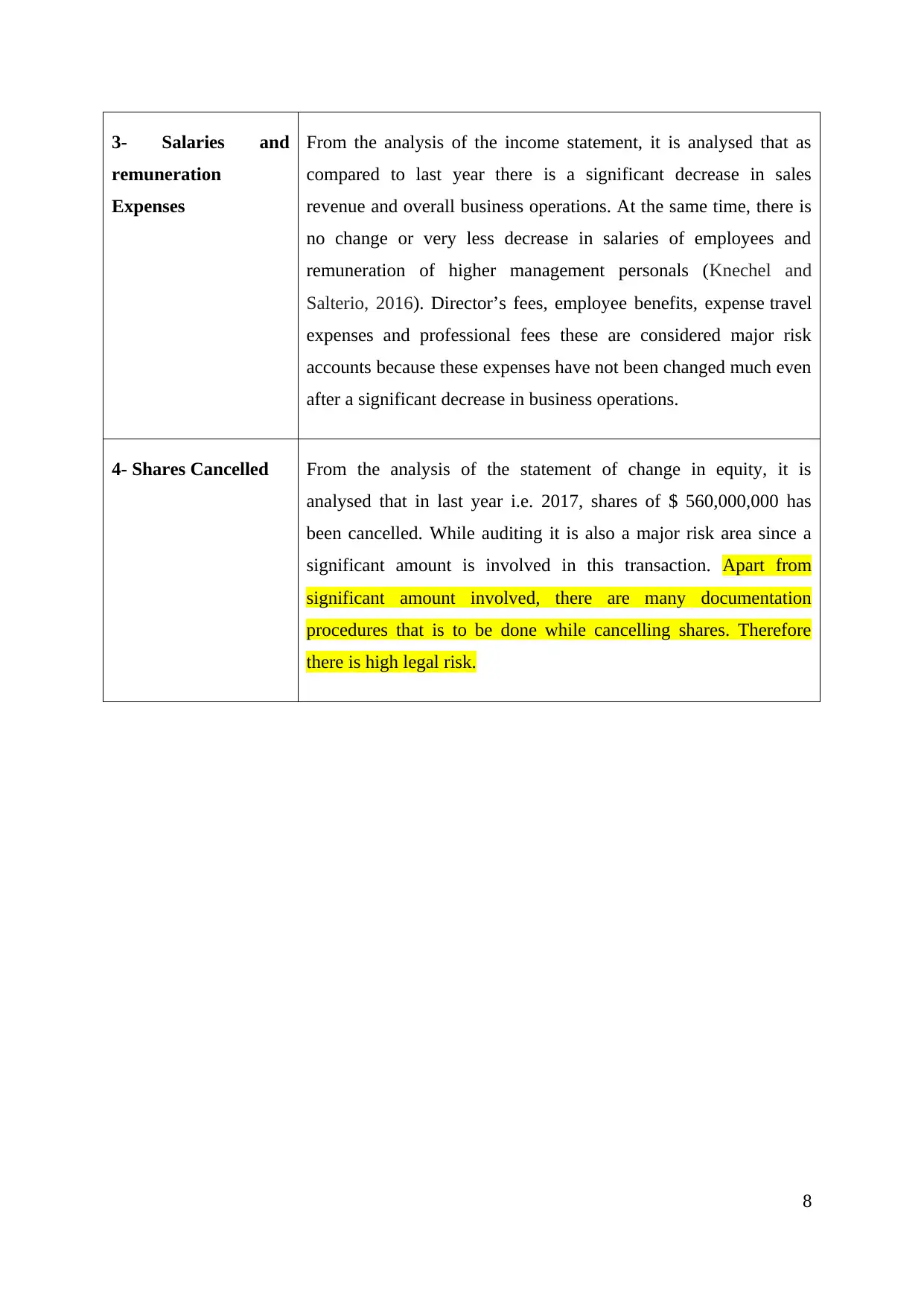
3- Salaries and
remuneration
Expenses
From the analysis of the income statement, it is analysed that as
compared to last year there is a significant decrease in sales
revenue and overall business operations. At the same time, there is
no change or very less decrease in salaries of employees and
remuneration of higher management personals (Knechel and
Salterio, 2016). Director’s fees, employee benefits, expense travel
expenses and professional fees these are considered major risk
accounts because these expenses have not been changed much even
after a significant decrease in business operations.
4- Shares Cancelled From the analysis of the statement of change in equity, it is
analysed that in last year i.e. 2017, shares of $ 560,000,000 has
been cancelled. While auditing it is also a major risk area since a
significant amount is involved in this transaction. Apart from
significant amount involved, there are many documentation
procedures that is to be done while cancelling shares. Therefore
there is high legal risk.
8
remuneration
Expenses
From the analysis of the income statement, it is analysed that as
compared to last year there is a significant decrease in sales
revenue and overall business operations. At the same time, there is
no change or very less decrease in salaries of employees and
remuneration of higher management personals (Knechel and
Salterio, 2016). Director’s fees, employee benefits, expense travel
expenses and professional fees these are considered major risk
accounts because these expenses have not been changed much even
after a significant decrease in business operations.
4- Shares Cancelled From the analysis of the statement of change in equity, it is
analysed that in last year i.e. 2017, shares of $ 560,000,000 has
been cancelled. While auditing it is also a major risk area since a
significant amount is involved in this transaction. Apart from
significant amount involved, there are many documentation
procedures that is to be done while cancelling shares. Therefore
there is high legal risk.
8
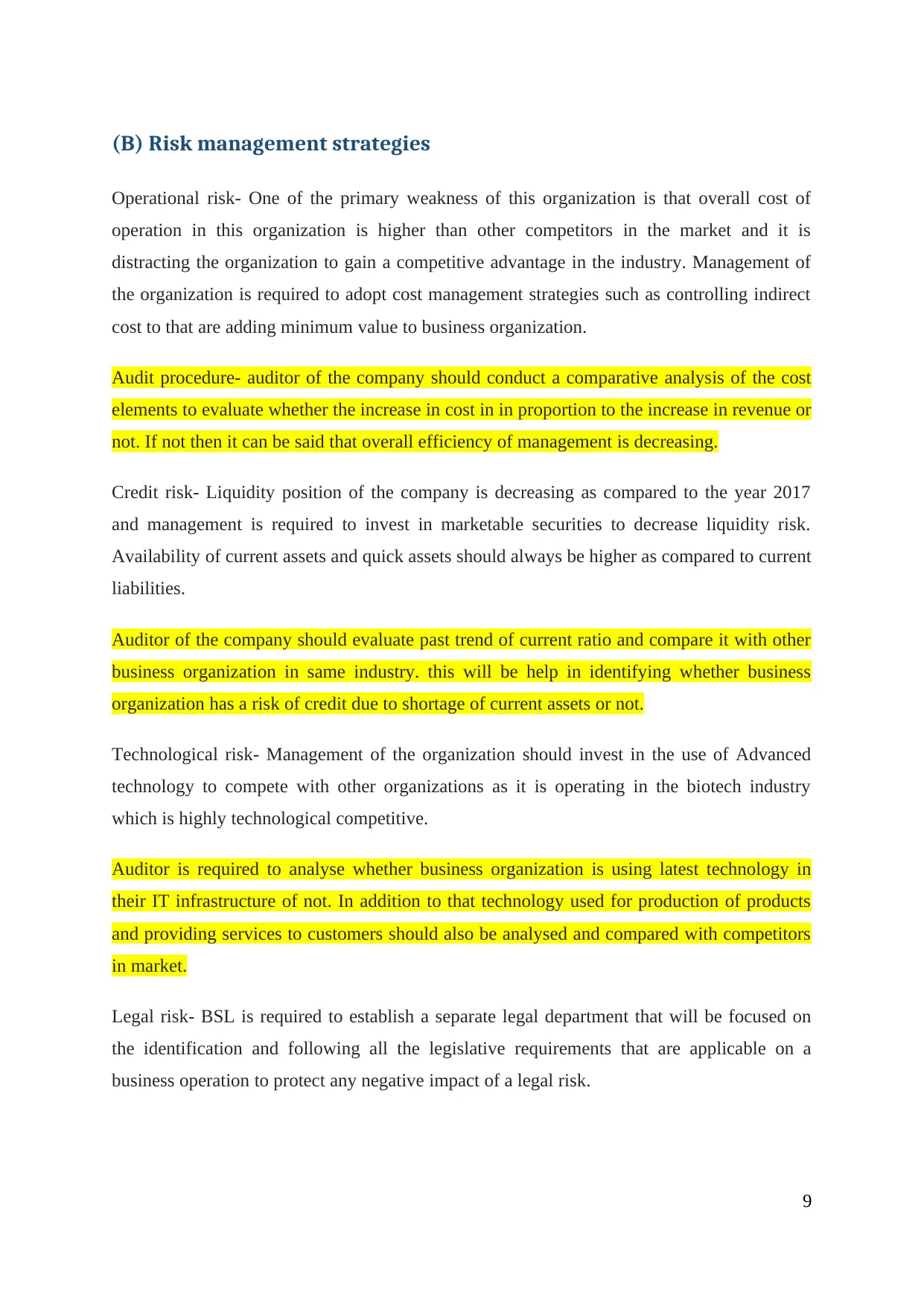
(B) Risk management strategies
Operational risk- One of the primary weakness of this organization is that overall cost of
operation in this organization is higher than other competitors in the market and it is
distracting the organization to gain a competitive advantage in the industry. Management of
the organization is required to adopt cost management strategies such as controlling indirect
cost to that are adding minimum value to business organization.
Audit procedure- auditor of the company should conduct a comparative analysis of the cost
elements to evaluate whether the increase in cost in in proportion to the increase in revenue or
not. If not then it can be said that overall efficiency of management is decreasing.
Credit risk- Liquidity position of the company is decreasing as compared to the year 2017
and management is required to invest in marketable securities to decrease liquidity risk.
Availability of current assets and quick assets should always be higher as compared to current
liabilities.
Auditor of the company should evaluate past trend of current ratio and compare it with other
business organization in same industry. this will be help in identifying whether business
organization has a risk of credit due to shortage of current assets or not.
Technological risk- Management of the organization should invest in the use of Advanced
technology to compete with other organizations as it is operating in the biotech industry
which is highly technological competitive.
Auditor is required to analyse whether business organization is using latest technology in
their IT infrastructure of not. In addition to that technology used for production of products
and providing services to customers should also be analysed and compared with competitors
in market.
Legal risk- BSL is required to establish a separate legal department that will be focused on
the identification and following all the legislative requirements that are applicable on a
business operation to protect any negative impact of a legal risk.
9
Operational risk- One of the primary weakness of this organization is that overall cost of
operation in this organization is higher than other competitors in the market and it is
distracting the organization to gain a competitive advantage in the industry. Management of
the organization is required to adopt cost management strategies such as controlling indirect
cost to that are adding minimum value to business organization.
Audit procedure- auditor of the company should conduct a comparative analysis of the cost
elements to evaluate whether the increase in cost in in proportion to the increase in revenue or
not. If not then it can be said that overall efficiency of management is decreasing.
Credit risk- Liquidity position of the company is decreasing as compared to the year 2017
and management is required to invest in marketable securities to decrease liquidity risk.
Availability of current assets and quick assets should always be higher as compared to current
liabilities.
Auditor of the company should evaluate past trend of current ratio and compare it with other
business organization in same industry. this will be help in identifying whether business
organization has a risk of credit due to shortage of current assets or not.
Technological risk- Management of the organization should invest in the use of Advanced
technology to compete with other organizations as it is operating in the biotech industry
which is highly technological competitive.
Auditor is required to analyse whether business organization is using latest technology in
their IT infrastructure of not. In addition to that technology used for production of products
and providing services to customers should also be analysed and compared with competitors
in market.
Legal risk- BSL is required to establish a separate legal department that will be focused on
the identification and following all the legislative requirements that are applicable on a
business operation to protect any negative impact of a legal risk.
9
⊘ This is a preview!⊘
Do you want full access?
Subscribe today to unlock all pages.

Trusted by 1+ million students worldwide
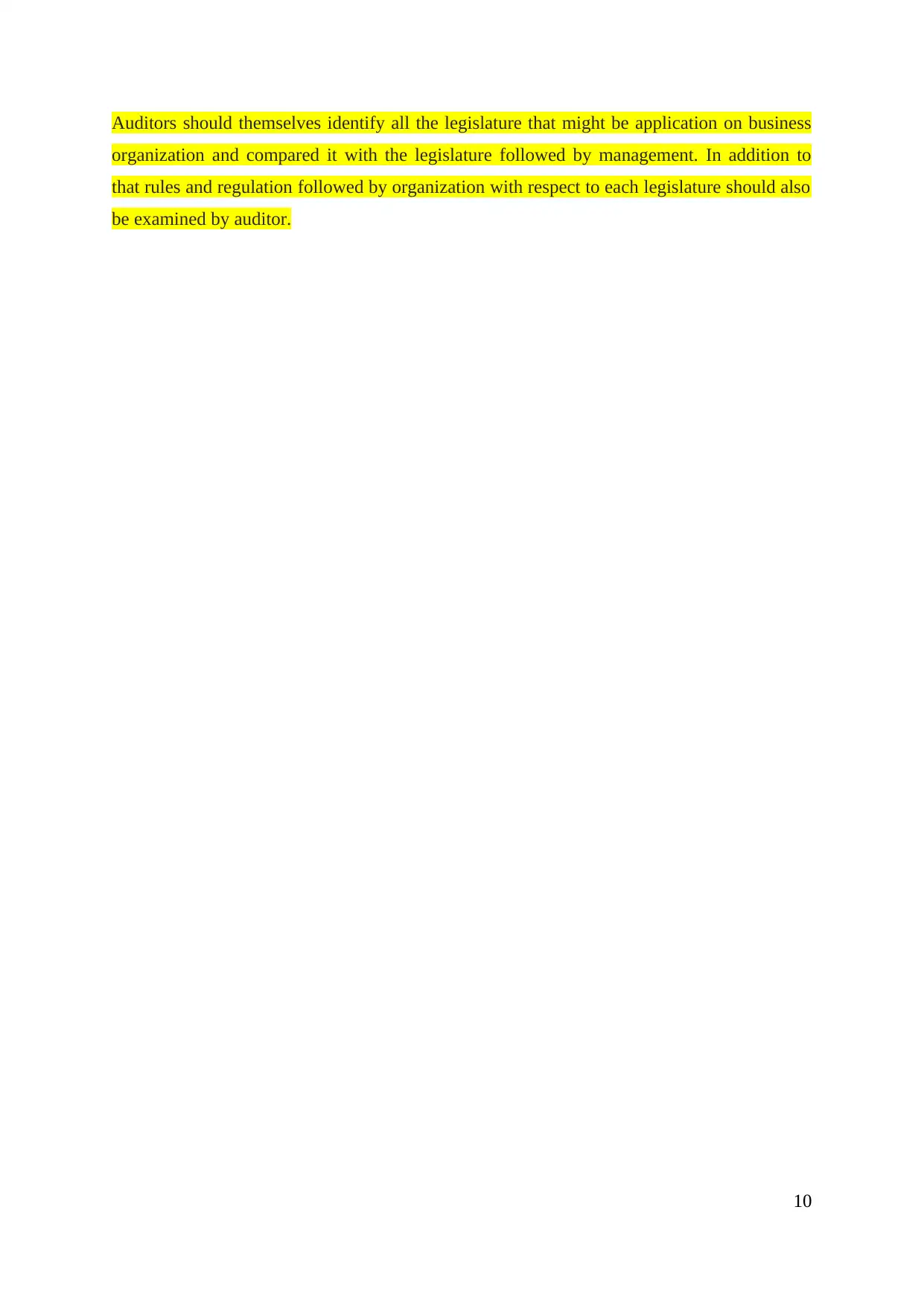
Auditors should themselves identify all the legislature that might be application on business
organization and compared it with the legislature followed by management. In addition to
that rules and regulation followed by organization with respect to each legislature should also
be examined by auditor.
10
organization and compared it with the legislature followed by management. In addition to
that rules and regulation followed by organization with respect to each legislature should also
be examined by auditor.
10
Paraphrase This Document
Need a fresh take? Get an instant paraphrase of this document with our AI Paraphraser
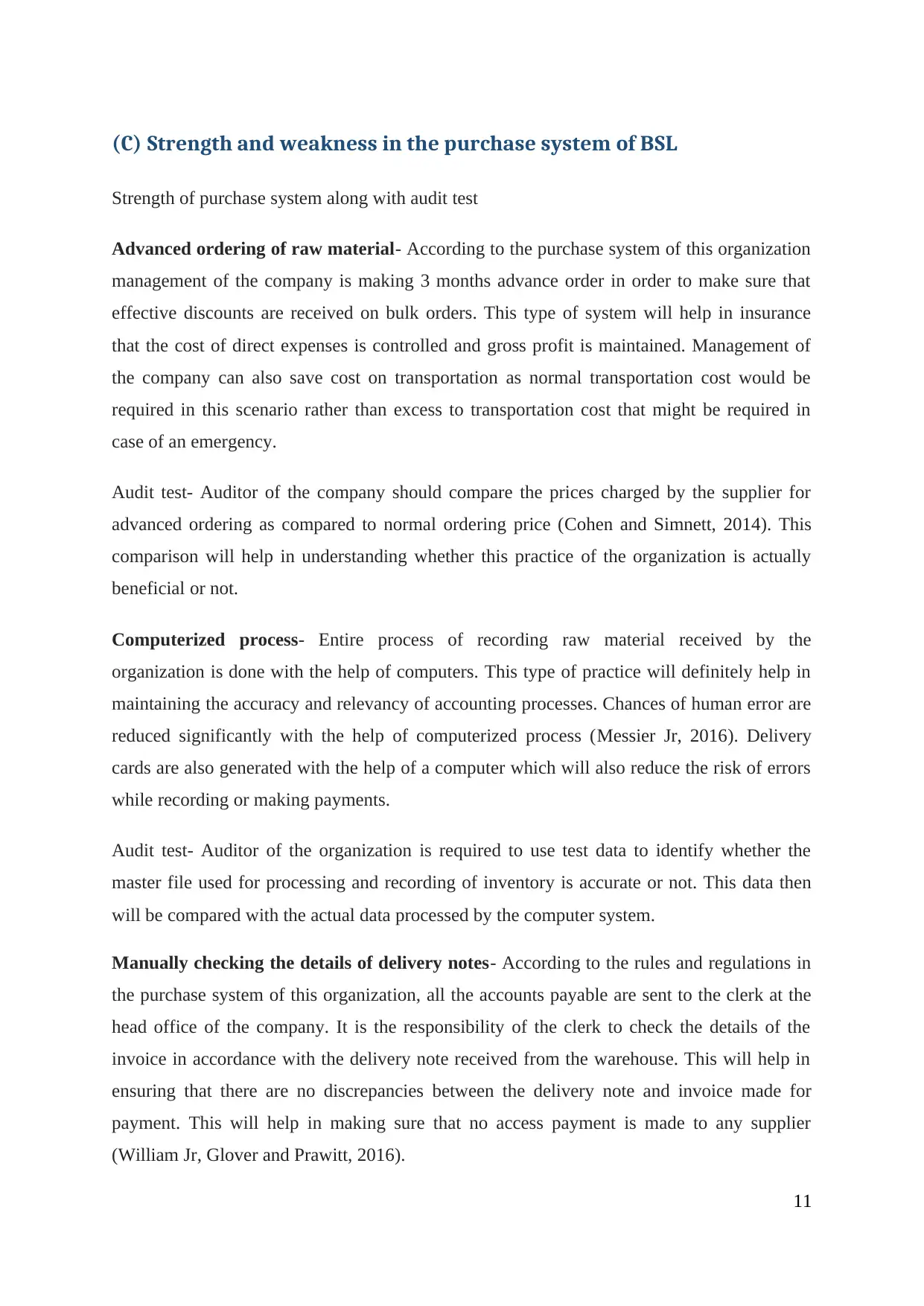
(C) Strength and weakness in the purchase system of BSL
Strength of purchase system along with audit test
Advanced ordering of raw material- According to the purchase system of this organization
management of the company is making 3 months advance order in order to make sure that
effective discounts are received on bulk orders. This type of system will help in insurance
that the cost of direct expenses is controlled and gross profit is maintained. Management of
the company can also save cost on transportation as normal transportation cost would be
required in this scenario rather than excess to transportation cost that might be required in
case of an emergency.
Audit test- Auditor of the company should compare the prices charged by the supplier for
advanced ordering as compared to normal ordering price (Cohen and Simnett, 2014). This
comparison will help in understanding whether this practice of the organization is actually
beneficial or not.
Computerized process- Entire process of recording raw material received by the
organization is done with the help of computers. This type of practice will definitely help in
maintaining the accuracy and relevancy of accounting processes. Chances of human error are
reduced significantly with the help of computerized process (Messier Jr, 2016). Delivery
cards are also generated with the help of a computer which will also reduce the risk of errors
while recording or making payments.
Audit test- Auditor of the organization is required to use test data to identify whether the
master file used for processing and recording of inventory is accurate or not. This data then
will be compared with the actual data processed by the computer system.
Manually checking the details of delivery notes- According to the rules and regulations in
the purchase system of this organization, all the accounts payable are sent to the clerk at the
head office of the company. It is the responsibility of the clerk to check the details of the
invoice in accordance with the delivery note received from the warehouse. This will help in
ensuring that there are no discrepancies between the delivery note and invoice made for
payment. This will help in making sure that no access payment is made to any supplier
(William Jr, Glover and Prawitt, 2016).
11
Strength of purchase system along with audit test
Advanced ordering of raw material- According to the purchase system of this organization
management of the company is making 3 months advance order in order to make sure that
effective discounts are received on bulk orders. This type of system will help in insurance
that the cost of direct expenses is controlled and gross profit is maintained. Management of
the company can also save cost on transportation as normal transportation cost would be
required in this scenario rather than excess to transportation cost that might be required in
case of an emergency.
Audit test- Auditor of the company should compare the prices charged by the supplier for
advanced ordering as compared to normal ordering price (Cohen and Simnett, 2014). This
comparison will help in understanding whether this practice of the organization is actually
beneficial or not.
Computerized process- Entire process of recording raw material received by the
organization is done with the help of computers. This type of practice will definitely help in
maintaining the accuracy and relevancy of accounting processes. Chances of human error are
reduced significantly with the help of computerized process (Messier Jr, 2016). Delivery
cards are also generated with the help of a computer which will also reduce the risk of errors
while recording or making payments.
Audit test- Auditor of the organization is required to use test data to identify whether the
master file used for processing and recording of inventory is accurate or not. This data then
will be compared with the actual data processed by the computer system.
Manually checking the details of delivery notes- According to the rules and regulations in
the purchase system of this organization, all the accounts payable are sent to the clerk at the
head office of the company. It is the responsibility of the clerk to check the details of the
invoice in accordance with the delivery note received from the warehouse. This will help in
ensuring that there are no discrepancies between the delivery note and invoice made for
payment. This will help in making sure that no access payment is made to any supplier
(William Jr, Glover and Prawitt, 2016).
11
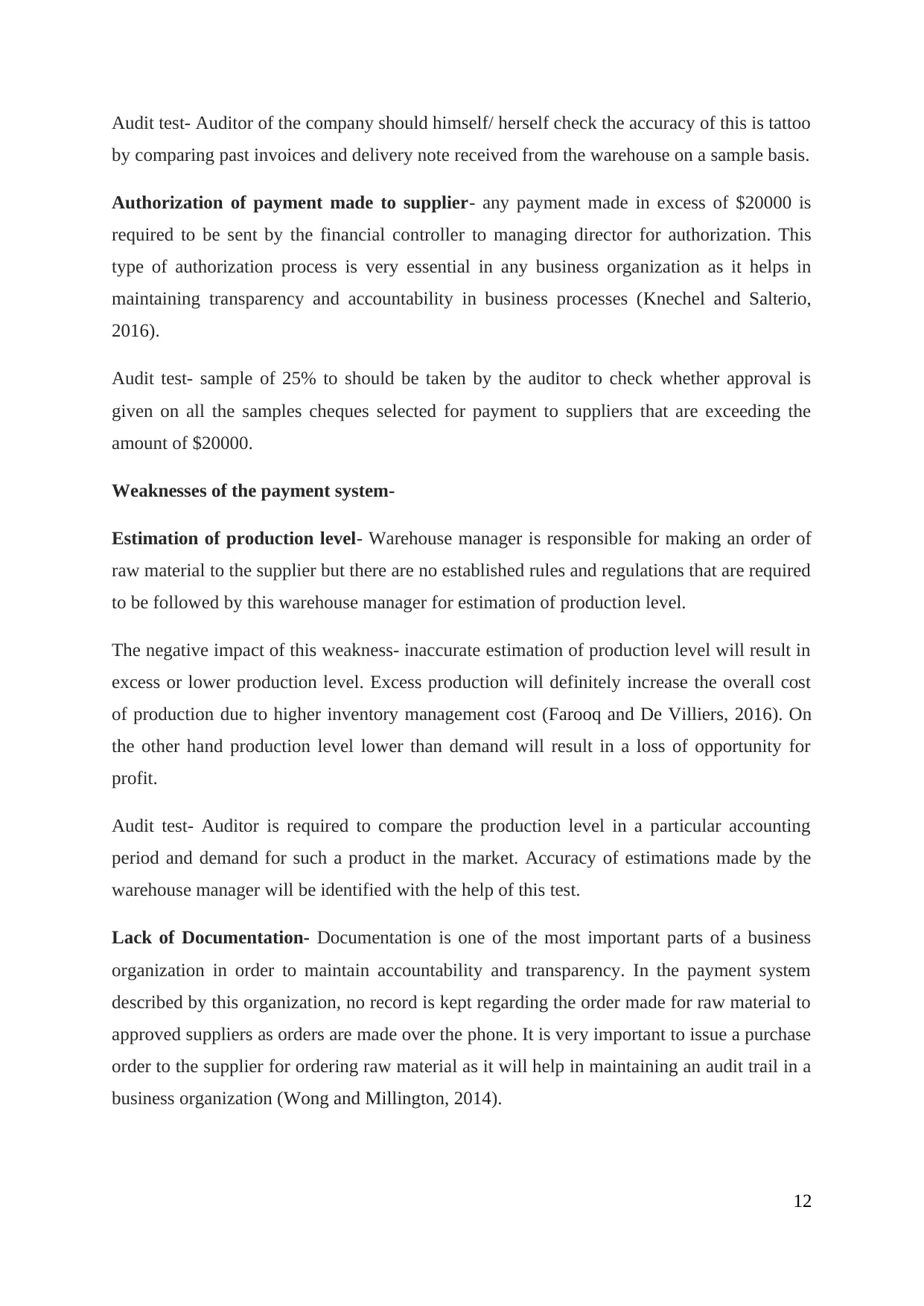
Audit test- Auditor of the company should himself/ herself check the accuracy of this is tattoo
by comparing past invoices and delivery note received from the warehouse on a sample basis.
Authorization of payment made to supplier- any payment made in excess of $20000 is
required to be sent by the financial controller to managing director for authorization. This
type of authorization process is very essential in any business organization as it helps in
maintaining transparency and accountability in business processes (Knechel and Salterio,
2016).
Audit test- sample of 25% to should be taken by the auditor to check whether approval is
given on all the samples cheques selected for payment to suppliers that are exceeding the
amount of $20000.
Weaknesses of the payment system-
Estimation of production level- Warehouse manager is responsible for making an order of
raw material to the supplier but there are no established rules and regulations that are required
to be followed by this warehouse manager for estimation of production level.
The negative impact of this weakness- inaccurate estimation of production level will result in
excess or lower production level. Excess production will definitely increase the overall cost
of production due to higher inventory management cost (Farooq and De Villiers, 2016). On
the other hand production level lower than demand will result in a loss of opportunity for
profit.
Audit test- Auditor is required to compare the production level in a particular accounting
period and demand for such a product in the market. Accuracy of estimations made by the
warehouse manager will be identified with the help of this test.
Lack of Documentation- Documentation is one of the most important parts of a business
organization in order to maintain accountability and transparency. In the payment system
described by this organization, no record is kept regarding the order made for raw material to
approved suppliers as orders are made over the phone. It is very important to issue a purchase
order to the supplier for ordering raw material as it will help in maintaining an audit trail in a
business organization (Wong and Millington, 2014).
12
by comparing past invoices and delivery note received from the warehouse on a sample basis.
Authorization of payment made to supplier- any payment made in excess of $20000 is
required to be sent by the financial controller to managing director for authorization. This
type of authorization process is very essential in any business organization as it helps in
maintaining transparency and accountability in business processes (Knechel and Salterio,
2016).
Audit test- sample of 25% to should be taken by the auditor to check whether approval is
given on all the samples cheques selected for payment to suppliers that are exceeding the
amount of $20000.
Weaknesses of the payment system-
Estimation of production level- Warehouse manager is responsible for making an order of
raw material to the supplier but there are no established rules and regulations that are required
to be followed by this warehouse manager for estimation of production level.
The negative impact of this weakness- inaccurate estimation of production level will result in
excess or lower production level. Excess production will definitely increase the overall cost
of production due to higher inventory management cost (Farooq and De Villiers, 2016). On
the other hand production level lower than demand will result in a loss of opportunity for
profit.
Audit test- Auditor is required to compare the production level in a particular accounting
period and demand for such a product in the market. Accuracy of estimations made by the
warehouse manager will be identified with the help of this test.
Lack of Documentation- Documentation is one of the most important parts of a business
organization in order to maintain accountability and transparency. In the payment system
described by this organization, no record is kept regarding the order made for raw material to
approved suppliers as orders are made over the phone. It is very important to issue a purchase
order to the supplier for ordering raw material as it will help in maintaining an audit trail in a
business organization (Wong and Millington, 2014).
12
⊘ This is a preview!⊘
Do you want full access?
Subscribe today to unlock all pages.

Trusted by 1+ million students worldwide
1 out of 21
Related Documents
Your All-in-One AI-Powered Toolkit for Academic Success.
+13062052269
info@desklib.com
Available 24*7 on WhatsApp / Email
![[object Object]](/_next/static/media/star-bottom.7253800d.svg)
Unlock your academic potential
Copyright © 2020–2025 A2Z Services. All Rights Reserved. Developed and managed by ZUCOL.





